An Alchemy of Junk
I first met Abigail DeVille in 2007 through a mutual friend, the photographer LaToya Ruby Frazier. We were at an after party for a group show I’d curated, called “Keeping Up With The Joneses.” As someone obsessed with fashion, I was struck immediately by DeVille’s dramatic style—a hairdo of sleek finger waves and Billie Holiday-esque flowers; a pair of door knockers swinging above a 1980s rabbit fur coat; and underneath, the peep of an African print.
Her street-smart vintage look was, as I would learn, the perfect prelude to her artistic practice, which is currently the subject of a survey exhibition—her first—at the Bronx Museum of the Arts, in the borough where she was born and raised. Called “Bronx Heavens,” the exhibition features her trademark site-specific installations, which in many ways mirror her style; her works’ dense assemblage of found and altered materials similarly transform the secondhand with theatrical effect. The sense of identity that clothes so often provide us is also at work, as DeVille recently shared with me. “Growing up in NYC in the 1980s and ’90s, fashion was about armor, what tribe you belonged to, and the signifiers that defined them,” she noted. “For me, it was about being tough. I was painfully shy as a kid. In high school, I cycled through outfits that shielded me from ridicule or helped me externalize or project the attitude I wanted.”
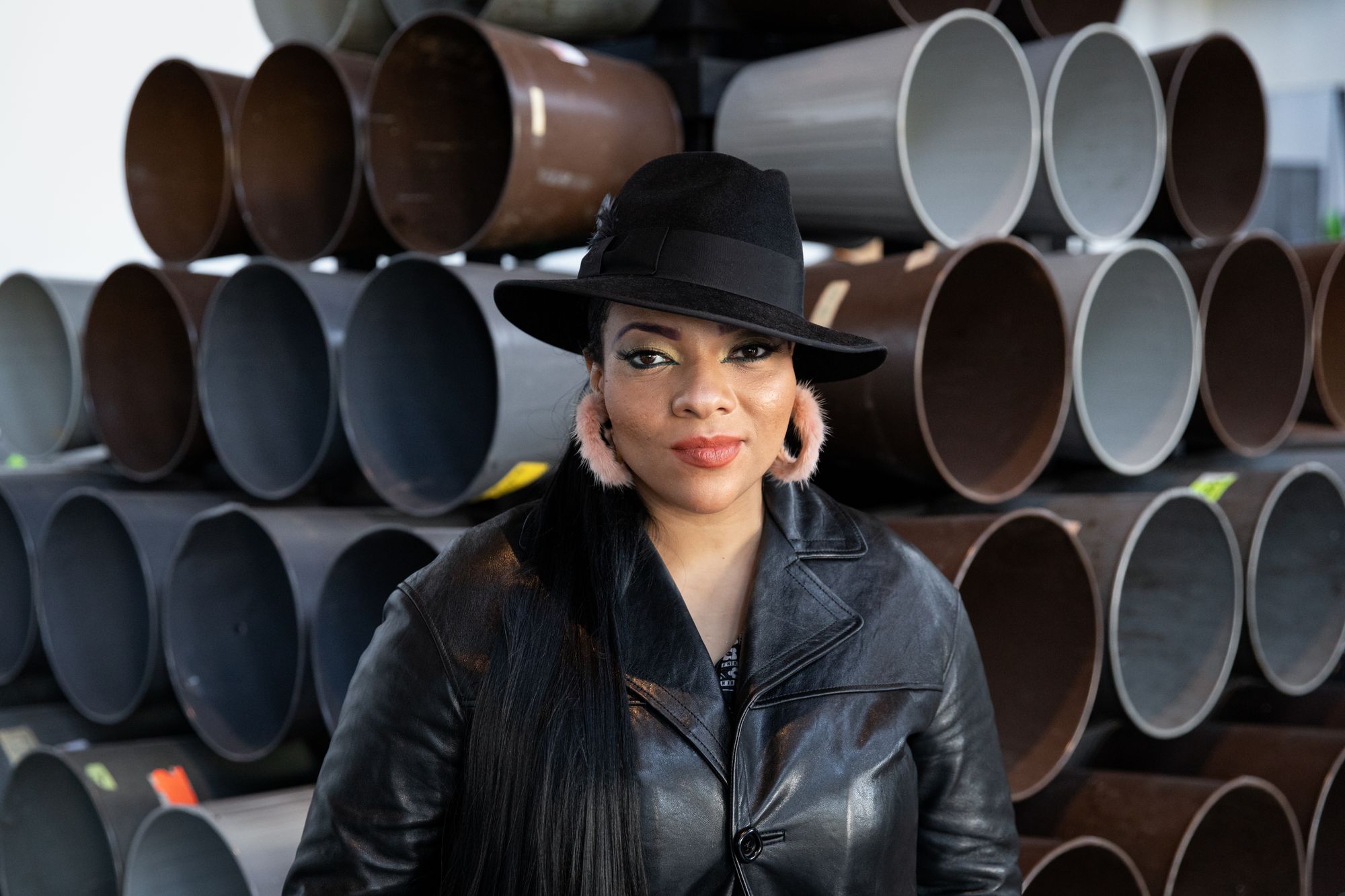
Abigail DeVille at “Brand New Heavies,” Pioneer Works, 2021.
Photo: Walter Wlodarczyk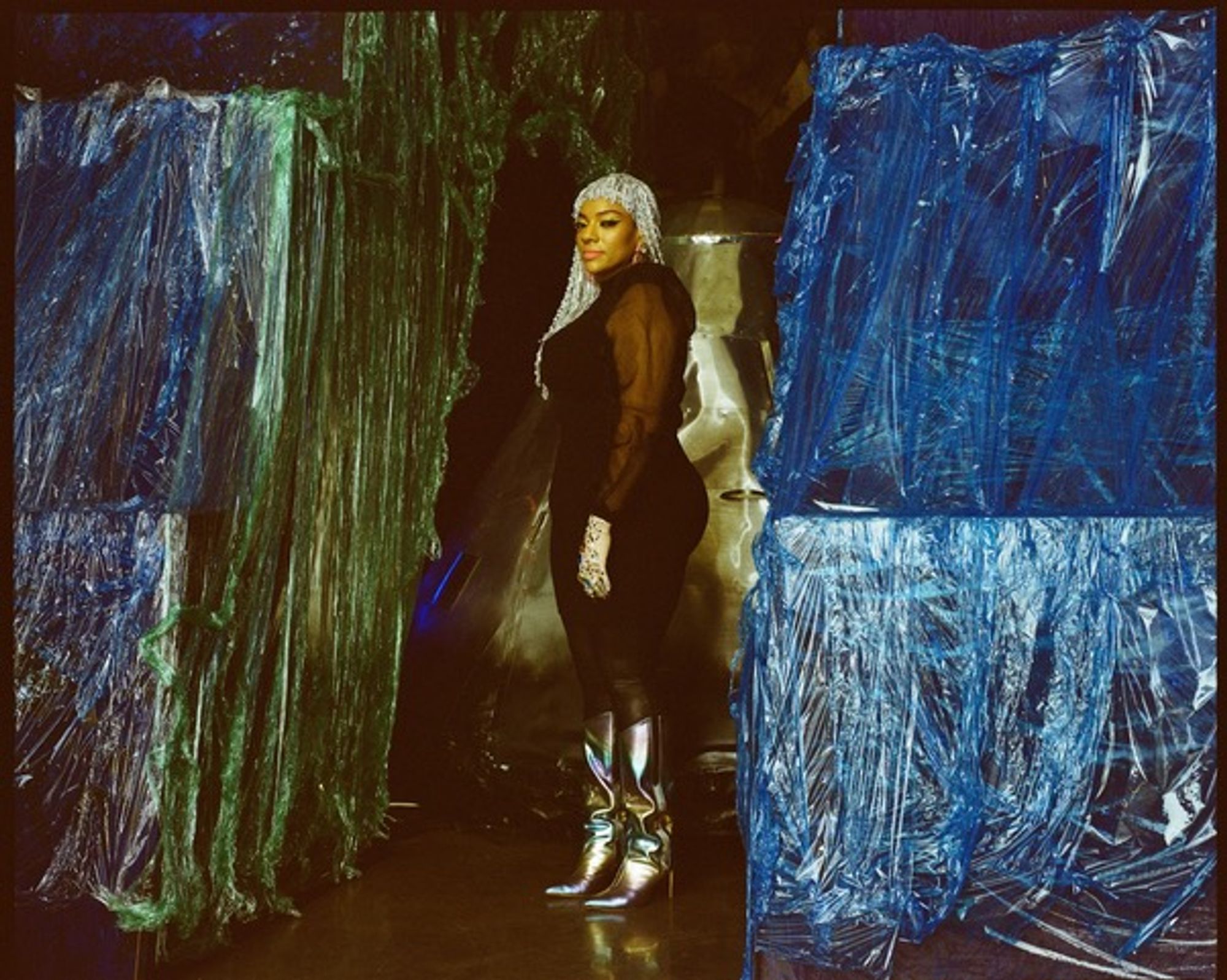
A portrait of Abigail DeVille by Flordalis Espinal for "Seen."

A portrait of Abigail DeVille by Flordalis Espinal for "Seen."
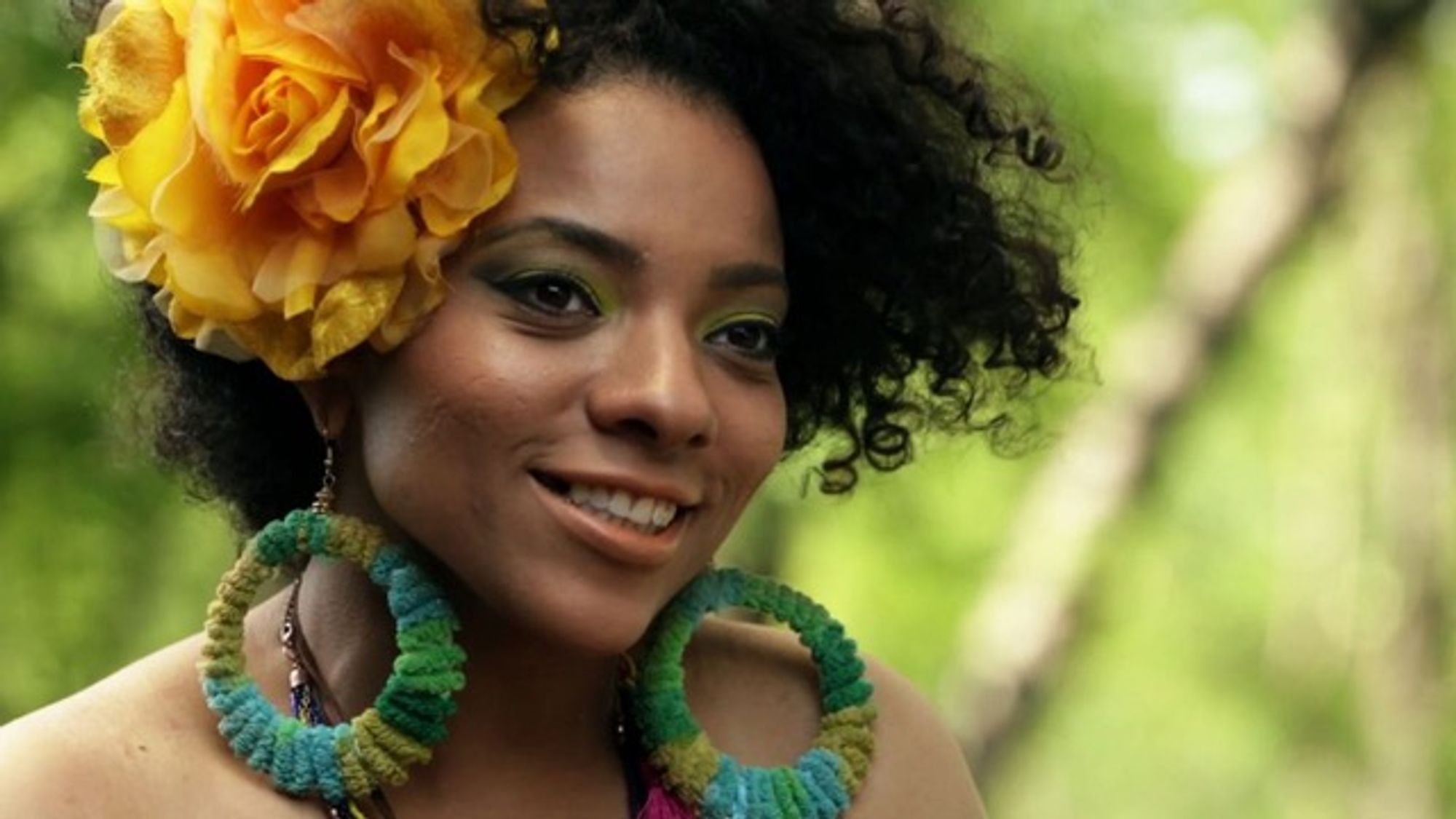
Ian Forster portrait of Abigail DeVille, taken in 2014 for Art21.
After that 2007 party, Frazier kept telling me I needed to check out DeVille’s work. While initially writing it off as a loyal friend’s supportive gesture, I started following the artist online. A few years later, I became intrigued by Facebook pictures of an installation she had done at Recess, in Brooklyn, called Dark Star (2010). I went to see it and was instantly smitten. There, in the swirling vortex of texture, light, and pattern—formed from wood lattices, striped tape lines, old snapshots, stretched fabric, and tunnels made of garbage bags—was the brilliant alchemy of her sartorial aesthetic, assembled out of the seemingly disparate and cacophonic. Of course, there was, and is, much more to Dark Star and DeVille’s work at large, which is deeply embedded in ideas of history, cosmology, race, and chaos theory; in the artist’s hands, such recurring themes involve and celebrate Black communities and their histories in ways that are uniquely engaged and thoughtfully collaborative.
Take her large-scale sculpture Haarlem Tower of Babel (2012), which was made during her residency at the Studio Museum in Harlem. It featured two skeletal spires about 15 feet high and built from reclaimed lumber: one was standing, the other toppled. Both were entangled in rusted metal parts and other vine-like materials—tree branches, chicken wire, rags—woven throughout the towers’ vertical slats. More “junk” in the form of old bicycle wheels, linoleum tile, china cups, broken fans, and faux autumn leaves adorned the standing tower’s shelves and spilled out across the floor. Among the detritus were some of DeVille’s favorite materials: mannequin parts, silver paint-splattered and punctured black tarps, and an overturned shopping cart. It reminded me of Arte Povera and assemblage traditions, or artists like David Hammons, Nari Ward, Rodney McMillian, and Noah Purifoy, who created something monumental out of nothing.
As intriguing as the work’s busy, tattered sprawl was the way time was embedded within it, imparting an accumulative, resonant power. When I later decided to include Haarlem Tower of Babel in an exhibition I was curating, “From The Ruins…,” I found out the work had been lying in DeVille’s father’s Bronx backyard since the Studio Museum residency and exhibition. This is typical of her work, which exists in a state of becoming: her rubble-like constructions summon a lost world caught between destruction and construction, hope and peril. They are in constant transition.
While her ad-hoc structures might fit in with the “ruin porn” trend in contemporary art and photography (popular culture, too), which fetishizes the aesthetics of decay, Deville’s work has different concerns. Her pieces are largely abstract, and more than trafficking in nihilistic fantasies of end times, they reinvigorate their source material in ways that are regenerative and rooted in a specific locality. In a sunset performance related to Haarlem Tower of Babel called The New Migration: Living Dead (Harlem) (2014), DeVille and friends led a communal procession decked out in futuristic Sun Ra-esque costumes, designed by the artist as wearable sculptures. They dragged a canoe-sized assemblage which gathered dirt and pebbles along the way as a chorus of drums and chants picked up speed. From Marcus Garvey Park down 124th Street and back to the museum courtyard, the funeral-like procession encouraged local residents to join in, and many did. Back at the Studio Museum, more singing, chanting, and rituals ensued that were deeply emotional. Inspired by the thousands of Black men and women who made their way north to Harlem during the Great Migration, the work was a nod both to Harlem luminary Jacob Lawrence’s iconic The Migration Series (1940-41) and an ode to four hundred years of African-American resilience. Like Haarlem Tower of Babel, the performance spoke to what DeVille calls “invisible histories”—the memories embedded in what we throw away and discard, and the stories buried by racism, neglect, and greed.
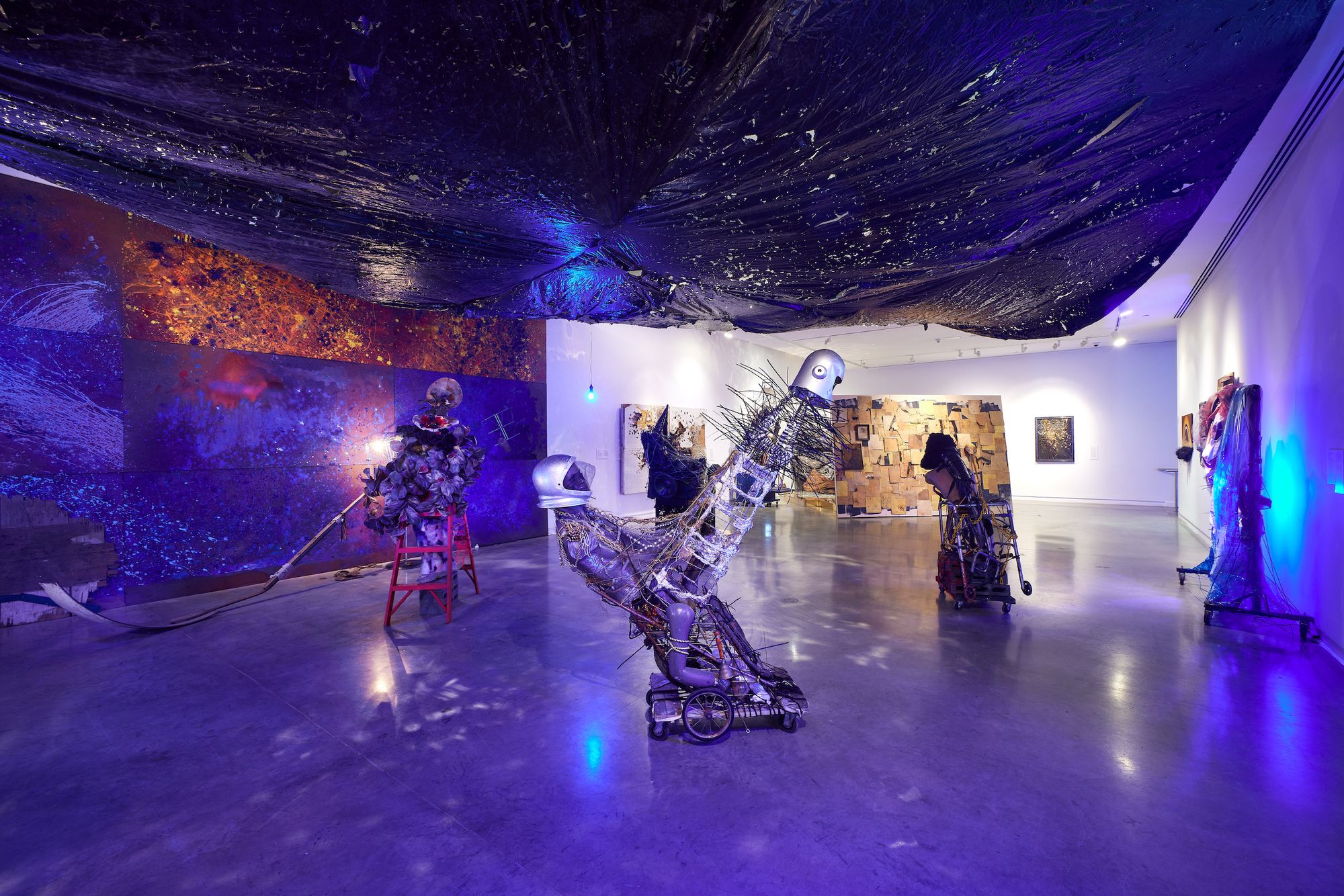
DeVille’s emphasis on Black liberation and a sci-fi vision of supernatural agency evoke the political aspects of Afrofuturism, as do her works’ titles, with their cosmological allusions and mentions of black holes: Dark Star (2010); If I don’t think I’m sinking, look at what a hole I’m in (2012); and Wild Seed (2013)—to name a few—as well one of her largest works to date, Only When It’s Dark Enough Can You See The Stars (2016). That work’s title directly quoted a fateful line in Martin Luther King, Jr.’s famous “mountain top speech” of April 3rd, 1968: “Trouble is in the land. Confusion all around. But I know, somehow, that only when it is dark enough, can you see the stars.” The work gestured to Afrofuturism not only in name but through reference to the civil rights icon’s address, which was delivered on the eve of Dr. King’s assassination in Memphis. The speech employed a vision of time travel to remind followers that change comes after great hardship.
Only When It’s Dark Enough invoked the Black Lives Matter movement—and the Freddie Gray protests in Baltimore in particular—as a contemporary parallel to the sanitation strike in Memphis and the violent police response that occasioned Dr. King’s speech. DeVille channeled his message through the material ghosts of the Peale, one of Baltimore’s oldest civic buildings. Her chief attraction to the Georgian-style building, which was built in 1814 but lay in ruins at the time of her installation, was to its myriad histories: as the first edifice in the west to be designed as a public museum; as the first building in the country to have electrical lighting; as Baltimore’s first City Hall; and as its first grammar school for Black children after the Civil War. By the twentieth century, after housing several private businesses, the Peale fell into disrepair until its reincarnation in 1931 as the Municipal Museum of Baltimore. By 1997, when it finally closed for good, it had become a place to dump trash, which is how DeVille found it. The artist spent months sorting through its detritus, as well scouring municipal archives, city dumps, and The Loading Dock, Inc. (a building materials reuse facility) for material.
Months of related research led her to outline a host of themes—from legislation and civil disobedience to nationalism and pedagogy—that gave insight to the building’s history as well as the works she unraveled throughout the Peale’s many spaces. In one strobe-lit room titled Black Hole (2016)—another nod to Afrofuturism—metal trash cans and glass bottles evoked the folk magic of bottle trees used to ward off evil by trapping bad spirits attracted to their sparkle. DeVille’s containers, though, felt less like talismans than conduits for the ancestors who once used them—generations of voices silenced by violence, oppression, and time. This aligned with DeVille’s use of the black hole as an analogy for historical erasure: “Bodies passed through holes in the fabric of time and didn’t make it out to the other side,” DeVille declared in an exhibition-related lecture. “They became the dust of the Earth, the air, the water we drink and the food we eat.” Another room installation, The People’s Theater (2016) featured church pews arranged around a small stage. Illuminated black tarps—crumpled and cut with holes—hung from the ceiling like constellations in the night sky. A commissioned score by contemporary composer Justin Hicks, based on a nineteenth-century children’s songbook, wafted through the air. References to contemporary Baltimore were also included: a figural sculpture wearing an Orioles baseball cap and jersey, recent BLM protest photographs, and tools for community organizing. These included a soapbox and vintage megaphone placed in the Peale’s backyard. As a testament to these activist intentions, musical performances, meetings, and lectures by local Baltimoreans were scheduled throughout the project’s run.
More recently, DeVille went south, visiting plantations to create new work that would “tell the true story” of forced migration in America, including the Trail of Tears that drove Native Americans from Appalachia to reservations out west. These pieces were eventually featured in her Pioneer Works installation The Observatory (2021), as part of the group exhibition “Brand New Heavies.” In the work, a hanging group of video monitors incorporated footage gathered from that ten-day trip, which enacted a kind of reverse migration. She told me at the time about a three-hundred-year old “hanging tree” she saw in Savannah, Georgia—a notorious site of lynching for which there had been no official commemoration—and of visiting Boone Hall Plantation in South Carolina. Shot glasses in the estate’s gift shop hailed the site as “one of America's oldest working plantations, continually growing crops for over 320 years.”
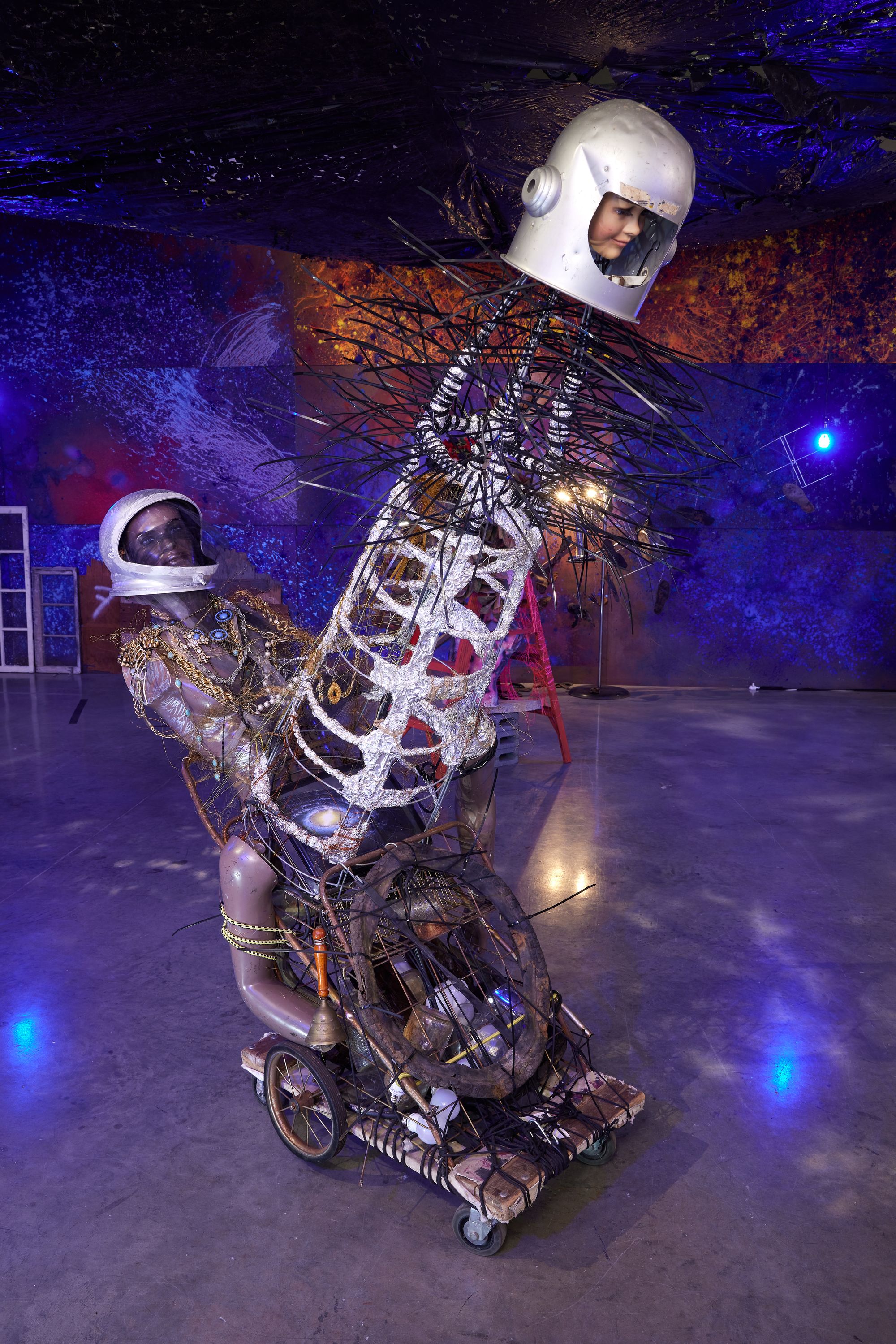
Keeping up with DeVille’s projects and travels has been nearly impossible given how prolific she is, but the culmination of her career is undoubtedly the current survey of her work at the Bronx Museum. This retrospective was organized around the artist’s familial and communal relationship to the history of the Bronx, a borough long known for its vibrant immigrant communities that has recently undergone extreme gentrification. Early pieces like Untitled (Cigarettes) and Ova The Rainbow (both 2009) are joined by several large-scale new installations created specifically for the exhibition. These include her time capsule cum spaceship, Lunar Capsule (2022), which weaves together the story of her family’s migration from Virginia to New York City with those gathered from visitors invited to record their own Bronx tales. The artist’s tendency to repurpose materials from previous installations of junk no doubt shaped the checklist accordingly; the exhibition contains mostly new works, since the old had been pillaged. But the emphasis on the new via the recycled invigorated the relationships between the past and the present explored throughout. Bathed in purple and blue lights, the kaleidoscopic “Bronx Heavens” moves the viewer through literal and cosmic space, asking us to consider “the convoluted notion of freedom in a country fraught with oppression and racism,” as the press release notes. The emphasis on community interaction and the power of telling one’s own story in the face of so much erasure signals the hope for a better future that has always animated DeVille’s practice.
The survey’s opening night celebration was a spectacle of love and admiration. It didn’t hurt that it also happened to be DeVille’s birthday. Dressed to kill as always, she stood tall in an off-the-shoulder, slinky tiger print dress and a pair of emerald green Chinese brocade platform booties. Holding a bouquet of red roses that reflected her bright pink lipstick and wearing a wavy, strawberry-blonde wig, she beamed at the crowd of family and friends as we sang her “Happy Birthday.” Known now for both her art and manner of dress, DeVille reveals the ways in which a highly developed personal style enhances and shapes an artist’s visual acumen. I asked the artist to share a formative fashion moment that, looking back, helped define who she is as an artist today: “My earliest fashion memory was seeing a beautiful Black woman wearing a tough punk leather jacket with metal studs on (the 1980s) graffiti-filled uptown 4 train, standing tall,” she told me. “It was burned in my memory; that was fashion. I was hip-hop gothic then, although I didn't know it. By the mid-’90s, hip-hop fashion skewed more conservative with polo shirts, khakis, button-down flannels, Timbs, and fly kicks. I wore all-black and monster Frankenstein platform boots with peacoats and khakis. It felt truer than pretending to care about the latest Jordans.” ♦
Subscribe to Broadcast